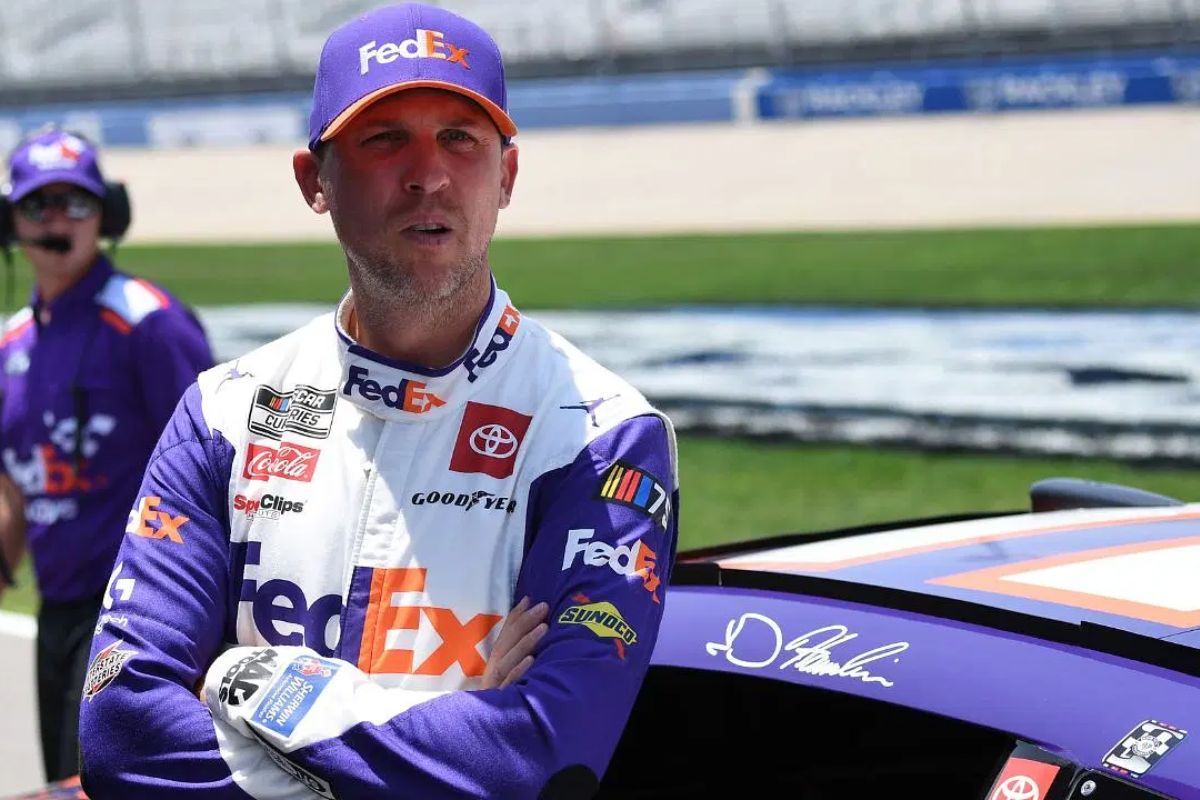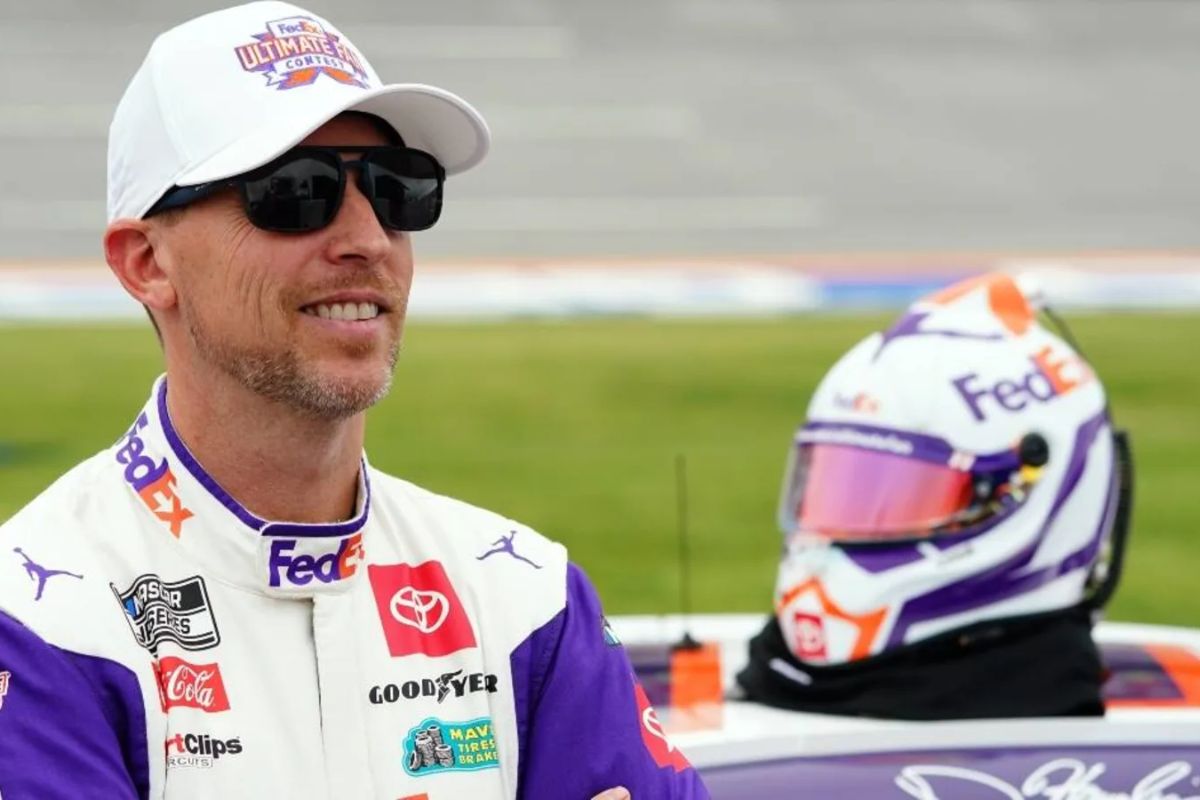Denny Hamlin Questions Chris Buescher: In NASCAR, the strategic interplay between racers can be as compelling as the race itself. Denny Hamlin‘s pointed critique of Chris Buescher‘s race decisions following Kyle Larson‘s recent win offers a fascinating insight into the tactical minds at play. Hamlin’s remarks on Buescher’s drafting choices and lane strategies not only highlight the critical importance of split-second decision-making but also hint at broader themes of risk assessment and competitive psychology in motorsports.
Key Takeaways
- Denny Hamlin critiqued Chris Buescher’s final lap decisions, suggesting more aggressive lane tactics.
- Hamlin believed Buescher should have forced Kyle Larson to a lower track position to secure the lead.
- He emphasized that Buescher’s cautious approach and timing misjudgments impacted his race outcome.
- Hamlin highlighted a missed tactical opportunity when Buescher chose the racing line in the final stretch.
- Despite his own race struggles, Hamlin focused on Buescher’s actions in the context of Kyle Larson’s winning maneuver.
Denny Hamlin’s Post-Race Analysis
In a thorough post-race analysis, Denny Hamlin offered an insightful critique of Chris Buescher’s final laps, suggesting strategic adjustments that could have secured him the victory at the 2024 Advent Health 400. Hamlin focused on Buescher’s approach during the critical final moments when the race’s outcome hung precariously in balance. Importantly, Hamlin pointed out the significant role of drafting techniques and situational awareness, which, if optimized, could have altered the finish.
Hamlin observed that Buescher maintained a cautious line throughout the race, preserving his vehicle’s integrity and ensuring he remained a key contender until the end, which ultimately led to Larson’s win. However, this cautious strategy may have been a double-edged sword. In the final laps, Buescher’s adherence to a safer racing line possibly prevented him from exploiting gaps that emerged sporadically, opportunities that a more aggressive driving approach could have utilized to overtake Larson.
Moreover, Hamlin noted Buescher’s timing in executing his push to the front. While his timing demonstrated his tactical skills, there was potentially a slight delay in his final surge. This minor hesitation allowed Larson to anticipate and counter Buescher’s moves effectively, thereby maintaining a slender lead.
He implied that Buescher could have intensified his challenge on Larson by varying his driving lines, thereby creating a psychological edge. This variation could have unsettled Larson or forced him into a defensive drive, disrupting his rhythm and potentially leading to a mistake that Buescher could capitalize on.

Denny Hamlin’s Advice to Buescher
Building on his critique of Chris Buescher’s race strategy, Denny Hamlin offered specific advice aimed at refining Buescher’s approach in future high-stress scenarios. As a seasoned driver, Hamlin recognized the critical moments that defined the race’s outcome and identified key areas where Buescher could improve his performance.
Hamlin suggested that maintaining a sharper focus during the race’s crucial final laps could prevent similar outcomes. He emphasized the importance of decisiveness in lane selection, particularly when leading under immense stress.
“I think running the middle (on Turns) one and two is what I would have done had I had a night to sleep on it and think about it.”
“Run the middle. You then force the #5 car in a place where he hasn’t completed a ton of passes all day which is the bottom. So you force him to the bottom. Now you come off the corner and if you’re clear which you should be, given the lead that he (Buescher) had entering turn 1. He (#5’s) going to have a worse run than you going down the backstretch and then into turn 3.”- hamlin
Additionally, Hamlin stressed the significance of adaptability in response to dynamic race conditions. He advised Buescher to be more responsive to the changing positions of competitors, especially in the critical stages of the race.
Hamlin’s Analysis of Buescher’s Final Lap Choice
Despite his P5 finish, Denny Hamlin offered a retrospective analysis of Chris Buescher’s final lap strategy, suggesting an alternative approach that might have secured a better outcome. Hamlin dissected the critical moments of the race on his podcast, proposing a tactical move that diverged markedly from Buescher’s actual decisions on the track.
“one lane or the other”. The #11 speculated an extreme measure, saying, “I mean he wasn’t done, right? I mean he still had an opportunity. If Buescher just barely taps the #5… So what would happen was that the #5 was so close to the wall that if he touched it at all… The #17 would’ve been clear sailing.”
Hamlin’s critique focused on the best racing line during the crucial last lap, where he believed Buescher could have utilized the middle lane more efficiently.
- Middle Lane Tactic: Hamlin suggested that Buescher should have opted for the middle lane in Turns 1 and 2. This choice would potentially offer a smoother and faster exit, setting up a stronger position for the remainder of the lap.
- Forcing the #5 Lower: By maintaining the middle lane, Buescher could have compelled Kyle Larson (#5) to choose a less favorable lower track position, a spot where Larson had not been commonly overtaking throughout the race.
- Securing the Lead: With a strategic middle lane positioning, Buescher would likely emerge ahead post-Turn 2, leveraging the lead built up entering the turn. This would place him in a commanding position against Larson heading into the critical backstretch.
- Impact on the Final Stretch: Hamlin posited that with Buescher leading out of Turn 2, Larson would have a diminished run down the backstretch, reducing his momentum and making it challenging for him to overtake in the final segments of the race.
Hamlin’s Further Evaluation
Hamlin’s critique highlights a fundamental divide in racing philosophy: the balance between assertive racing and maintaining sportsmanship. He suggested that Buescher’s hesitation to nudge Larson’s #5 car, which was already perilously close to the wall, epitomized a missed strategic opportunity. According to Hamlin, the physicality of racing—often encapsulated in the adage ‘rubbing is racing’—was underutilized by Buescher in those final moments.
“But I think that Buescher just is not willing to do that. He wanted to race it out fairly and come into the line. But the #5 turned left on him and really killed the momentum the #17 had.” – hamlin
Furthermore, Hamlin’s analysis of the event where Larson turned left, effectively stalling Buescher’s momentum, provides an additional layer of complexity. It highlights the dynamic and often instantaneous decisions drivers must make, which can define the outcome of a race.
Hamlin’s Own Race Struggles
Denny Hamlin faced significant challenges in the race’s closing stages, particularly after a strategic two-tire pit stop led to complications that hindered his performance on the final lap. This decision, aimed at gaining track position, instead left Hamlin vulnerable in a critical moment of the race.
“So I had my own issues getting off turn 2 on that last lap because the #19, I was about to clear him and I come down the track. He dumps air on the left side, I start getting tight. I see Chase coming. I check up to them… So I get passed by both of them, and I’m watching what’s going on in the front because I’m thinking how do I set myself up here?” – hamlin
Hamlin’s difficulties were not isolated incidents but part of a broader narrative that unfolded under the stress conditions of the final laps.
- Strategic Pit Stop: Opting for two tires rather than four was a calculated risk that did not pay off. This choice was pivotal in determining his track position and subsequent ability to defend or advance.
- Aerodynamic Disadvantage: Exiting turn 2, Hamlin encountered aerodynamic disturbances caused by the #19 car. The loss of downforce on his car led to a tight condition, compromising his speed and agility.
- Competitive Reaction: The immediate challenge from Chase Elliott, who capitalized on Hamlin’s compromised position, forced him to adjust his racing line and strategy abruptly.
- Focus Shift: Amidst his struggles, Hamlin was also cognizant of the leaders’ battle ahead, splitting his focus between his immediate predicament and the potential opportunities to capitalize on any mistakes by the frontrunners.
News in Brief: Denny Hamlin Questions Chris Buescher
Denny Hamlin’s insightful post-race analysis demonstrates the crucial role of strategic decision-making in NASCAR. By analyzing Chris Buescher’s choices during the race, Hamlin not only emphasizes the importance of adaptability and tactical expertise but also contributes to a broader understanding of competitive dynamics in motorsports.
This interaction highlights the need for continuous improvement and mental agility, crucial for success in the environment of professional racing.
Our Reader’s Queries
Q. Are Denny Hamlin and Kyle Larson friends?
A. Off the track, Hamlin and Larson share a camaraderie that seems unaffected by their on-track rivalries. Their friendship endures despite any competitive clashes they may have encountered.
Q. Who is Kyle Larson friends with?
A. In a candid exchange, Kyle Larson affirms that he maintains a friendship with Denny Hamlin. However, he suggests that Hamlin’s racing style towards him doesn’t always reflect that camaraderie, using a pointed term to illustrate his sentiment.
Q. Has Denny Hamlin ever won a road race?
A. In a remarkable turn of events, Hamlin clinched his inaugural road course triumph by commanding just 10 laps out of the 90-lap contest, notably seizing control in the crucial final moments. This win served as redemption for Hamlin, who narrowly missed victory at Sonoma Raceway earlier in the season due to a last-lap slip-up, allowing Tony Stewart to snatch the win.
ALSO READ: Denny Hamlin Takes a Dig at Martin Truex Jr. Over Kansas Ultimate Slip-Up



